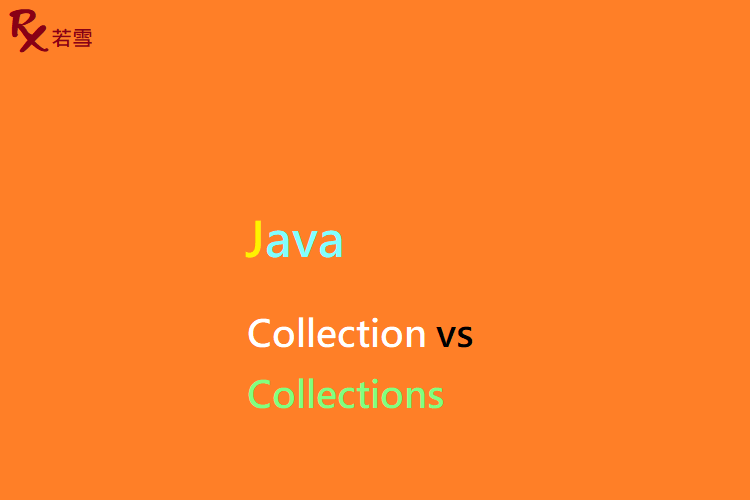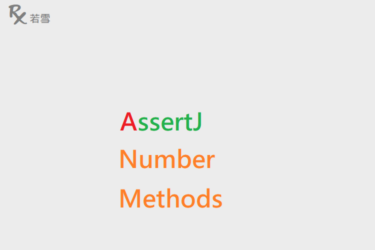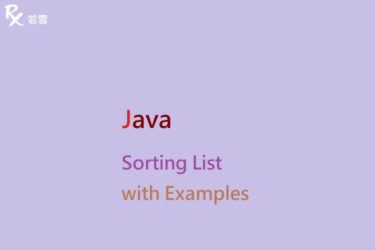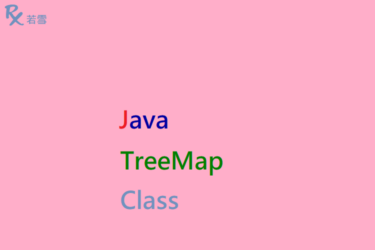Table of Contents
ToggleCollection vs Collections in Java
接口 Collection 提供 add 、 remove 、 clear 、 size 和 contains 等重要方法,是 Java 集合框架的根接口,將一組單獨的物件表示為一個單元,而工具類別 Collections 提供 addAll 、 sort 、 max 和 min 等重要方法,定義用於操作集合的實用方法,只包含靜態方法, Collections vs Collection in Java 提供這兩種接口及類別的操作使用方式,本篇增加了範例,並透過單元測試來驗證產出結果。
| Collection Interface | Collections Class |
|---|---|
| 宣告為接口 | 實用工具類別 |
| 用於將物件分組為單一單元 | 定義用於操作集合的實用方法 |
| 從 Java 8 開始包含靜態方法的接口、抽象方法和預設方法 | 只包含靜態方法 |
| 繼承 Iterable 接口 | 繼承 Object 物件 |
檔案目錄
./
+- src
+- test
| +- org
| +- ruoxue
| +- java_147
| +- collection
| +- CollectionVSCollectionsTest.java 單元測試
Java Collection vs Collections 提供集合元素等操作。
Fruit
建立 Fruit 類別,覆寫 toString ,定義屬性和方法,用來建立一個物件。
@NoArgsConstructor
@Getter
@Setter
@Builder
public static class Fruit implements Comparable<Fruit> {
private String name;
private double quantity;
private int type;
public Fruit(String name, double quantity, int type) {
this.name = name;
this.quantity = quantity;
this.type = type;
}
public String toString() {
ToStringBuilder builder = new ToStringBuilder(this, ToStringStyle.JSON_STYLE);
builder.appendSuper(super.toString());
builder.append("name", name);
builder.append("quantity", quantity);
builder.append("type", type);
return builder.toString();
}
@Override
public int compareTo(Fruit o) {
int result = this.name.compareTo(o.name);
if (result == 0)
result = Double.compare(this.quantity, o.quantity);
return result;
}
}addAll
Java Collection vs Collections 建立兩個 Collection ,使用給定的 Collection 物件,初始化三個元素。
@Test
public void addAll() {
int expectedSize = 3;
Fruit apple = new Fruit("Apple", Double.MAX_VALUE, 1);
Fruit banana = new Fruit("Banana", -1, 3);
Fruit cherry = new Fruit("Cherry", 3, 1);
Collection<Fruit> collection = Lists.newArrayList(apple, banana, cherry);
Collection<Fruit> result = new ArrayList<>();
result.addAll(collection);
System.out.println(result);
assertEquals(expectedSize, result.size());
Fruit mango = new Fruit("Mango", Double.MAX_VALUE, 1);
Fruit orange = new Fruit("Orange", -1, 3);
Fruit peach = new Fruit("Peach", 3, 1);
Collections.addAll(result, mango, orange, peach);
System.out.println(result);
assertEquals(6, result.size());
}[{"name":"Apple","quantity":1.7976931348623157E308,"type":1}, {"name":"Banana","quantity":-1.0,"type":3}, {"name":"Cherry","quantity":3.0,"type":1}]
[{"name":"Apple","quantity":1.7976931348623157E308,"type":1}, {"name":"Banana","quantity":-1.0,"type":3}, {"name":"Cherry","quantity":3.0,"type":1}, {"name":"Mango","quantity":1.7976931348623157E308,"type":1}, {"name":"Orange","quantity":-1.0,"type":3}, {"name":"Peach","quantity":3.0,"type":1}]
sort
Java Collection vs Collections 建立一個 List ,增加三個元素,使用 list sort 及 Collections sort 方法,依照預設比較器,由小到大,升序對集合進行排序。
@Test
public void sort() {
Fruit banana = new Fruit("Banana", -1, 3);
Fruit apple = new Fruit("Apple", Double.MAX_VALUE, 1);
Fruit cherry = new Fruit("Cherry", 3, 1);
List<Fruit> list = Lists.newArrayList(banana, apple, cherry);
System.out.println(list);
list.sort(null);
System.out.println(list);
assertThat(list).containsExactly(apple, banana, cherry);
Fruit orange = new Fruit("Orange", -1, 3);
Fruit mango = new Fruit("Mango", Double.MAX_VALUE, 1);
Fruit peach = new Fruit("Peach", 3, 1);
list = Lists.newArrayList(orange, mango, peach);
System.out.println(list);
Collections.sort(list);
System.out.println(list);
assertThat(list).containsExactly(mango, orange, peach);
}[{"name":"Banana","quantity":-1.0,"type":3}, {"name":"Apple","quantity":1.7976931348623157E308,"type":1}, {"name":"Cherry","quantity":3.0,"type":1}]
[{"name":"Apple","quantity":1.7976931348623157E308,"type":1}, {"name":"Banana","quantity":-1.0,"type":3}, {"name":"Cherry","quantity":3.0,"type":1}]
[{"name":"Orange","quantity":-1.0,"type":3}, {"name":"Mango","quantity":1.7976931348623157E308,"type":1}, {"name":"Peach","quantity":3.0,"type":1}]
[{"name":"Mango","quantity":1.7976931348623157E308,"type":1}, {"name":"Orange","quantity":-1.0,"type":3}, {"name":"Peach","quantity":3.0,"type":1}]
min
Java Collection vs Collections 建立一個 Collection ,內有三個元素,取最小元素。
@Test
public void min() {
Fruit apple = new Fruit("Apple", Double.MAX_VALUE, 1);
Fruit banana = new Fruit("Banana", -1, 3);
Fruit cherry = new Fruit("Cherry", 3, 1);
Collection<Fruit> collection = Lists.newArrayList(apple, banana, cherry);
Fruit result = Collections.min(collection, Comparator.comparing(Fruit::getQuantity));
System.out.println(result);
assertThat(result).isEqualTo(banana);
}{"name":"Banana","quantity":-1.0,"type":3}max
Java Collections vs Collection 建立一個 Collection ,內有三個元素,取最大元素。
@Test
public void max() {
Fruit apple = new Fruit("Apple", Double.MAX_VALUE, 1);
Fruit banana = new Fruit("Banana", -1, 3);
Fruit cherry = new Fruit("Cherry", 3, 1);
Collection<Fruit> collection = Lists.newArrayList(apple, banana, cherry);
Fruit result = Collections.max(collection, Comparator.comparing(Fruit::getQuantity));
System.out.println(result);
assertThat(result).isEqualTo(apple);
}{"name":"Apple","quantity":1.7976931348623157E308,"type":1}replaceAll
Java Collections vs Collection 建立一個 Collection ,內有三個元素,取代指定元素, Collection vs Collections 提供範例參考。
@Test
public void replaceAll() {
Fruit apple = new Fruit("Apple", Double.MAX_VALUE, 1);
Fruit banana = new Fruit("Banana", -1, 3);
Fruit cherry = new Fruit("Cherry", 3, 1);
List<Fruit> list = Lists.newArrayList(apple, banana, cherry, apple);
System.out.println(list);
Fruit orange = new Fruit("Orange", -1, 3);
boolean result = Collections.replaceAll(list, apple, orange);
System.out.println(list);
System.out.println(result);
assertThat(result).isTrue();
}[{"name":"Apple","quantity":1.7976931348623157E308,"type":1}, {"name":"Banana","quantity":-1.0,"type":3}, {"name":"Cherry","quantity":3.0,"type":1}, {"name":"Apple","quantity":1.7976931348623157E308,"type":1}]
[{"name":"Orange","quantity":-1.0,"type":3}, {"name":"Banana","quantity":-1.0,"type":3}, {"name":"Cherry","quantity":3.0,"type":1}, {"name":"Orange","quantity":-1.0,"type":3}]
trueenumeration
Collection vs Collections 建立一個 Collection ,增加三個元素,使用 iterator 及 enumeration 遍歷元素,輸出在 console 上。
@Test
public void enumeration() {
Fruit apple = new Fruit("Apple", Double.MAX_VALUE, 1);
Fruit banana = new Fruit("Banana", -1, 3);
Fruit cherry = new Fruit("Cherry", 3, 1);
Collection<Fruit> collection = Lists.newArrayList(apple, banana, cherry);
Iterator<Fruit> it = collection.iterator();
while (it.hasNext()) {
Fruit e = it.next();
System.out.println(e);
}
Enumeration<Fruit> en = Collections.enumeration(collection);
while (en.hasMoreElements()) {
Fruit e = en.nextElement();
System.out.println(e);
}
}{"name":"Apple","quantity":1.7976931348623157E308,"type":1}
{"name":"Banana","quantity":-1.0,"type":3}
{"name":"Cherry","quantity":3.0,"type":1}
{"name":"Apple","quantity":1.7976931348623157E308,"type":1}
{"name":"Banana","quantity":-1.0,"type":3}
{"name":"Cherry","quantity":3.0,"type":1}list
Collection vs Collections 建立一個 Vector ,增加三個元素,使用 list 轉換成 ArrayList 。
@Test
public void list() {
int expectedSize = 3;
Vector<Fruit> vector = new Vector<>();
vector.add(new Fruit("Apple", Double.MAX_VALUE, 1));
vector.add(new Fruit("Banana", -1, 3));
vector.add(new Fruit("Cherry", 3, 1));
List<Fruit> result = Collections.list(vector.elements());
System.out.println(result);
assertEquals(expectedSize, result.size());
}[{"name":"Apple","quantity":1.7976931348623157E308,"type":1}, {"name":"Banana","quantity":-1.0,"type":3}, {"name":"Cherry","quantity":3.0,"type":1}]CollectionVSCollectionsTest.java
Java Collections vs Collection 新增單元測試,驗證 Collection vs Collections 是否符合預期。
package org.ruoxue.java_147.collection;
import static org.assertj.core.api.Assertions.assertThat;
import static org.junit.Assert.assertEquals;
import java.util.ArrayList;
import java.util.Collection;
import java.util.Collections;
import java.util.Comparator;
import java.util.Enumeration;
import java.util.Iterator;
import java.util.List;
import java.util.Vector;
import org.apache.commons.lang3.builder.ToStringBuilder;
import org.apache.commons.lang3.builder.ToStringStyle;
import org.junit.Test;
import com.google.common.collect.Lists;
import lombok.Builder;
import lombok.Getter;
import lombok.NoArgsConstructor;
import lombok.Setter;
public class CollectionVSCollectionsTest {
@NoArgsConstructor
@Getter
@Setter
@Builder
public static class Fruit implements Comparable<Fruit> {
private String name;
private double quantity;
private int type;
public Fruit(String name, double quantity, int type) {
this.name = name;
this.quantity = quantity;
this.type = type;
}
public String toString() {
ToStringBuilder builder = new ToStringBuilder(this, ToStringStyle.JSON_STYLE);
builder.appendSuper(super.toString());
builder.append("name", name);
builder.append("quantity", quantity);
builder.append("type", type);
return builder.toString();
}
@Override
public int compareTo(Fruit o) {
int result = this.name.compareTo(o.name);
if (result == 0)
result = Double.compare(this.quantity, o.quantity);
return result;
}
}
@Test
public void addAll() {
int expectedSize = 3;
Fruit apple = new Fruit("Apple", Double.MAX_VALUE, 1);
Fruit banana = new Fruit("Banana", -1, 3);
Fruit cherry = new Fruit("Cherry", 3, 1);
Collection<Fruit> collection = Lists.newArrayList(apple, banana, cherry);
Collection<Fruit> result = new ArrayList<>();
result.addAll(collection);
System.out.println(result);
assertEquals(expectedSize, result.size());
Fruit mango = new Fruit("Mango", Double.MAX_VALUE, 1);
Fruit orange = new Fruit("Orange", -1, 3);
Fruit peach = new Fruit("Peach", 3, 1);
Collections.addAll(result, mango, orange, peach);
System.out.println(result);
assertEquals(6, result.size());
}
@Test
public void sort() {
Fruit banana = new Fruit("Banana", -1, 3);
Fruit apple = new Fruit("Apple", Double.MAX_VALUE, 1);
Fruit cherry = new Fruit("Cherry", 3, 1);
List<Fruit> list = Lists.newArrayList(banana, apple, cherry);
System.out.println(list);
list.sort(null);
System.out.println(list);
assertThat(list).containsExactly(apple, banana, cherry);
Fruit orange = new Fruit("Orange", -1, 3);
Fruit mango = new Fruit("Mango", Double.MAX_VALUE, 1);
Fruit peach = new Fruit("Peach", 3, 1);
list = Lists.newArrayList(orange, mango, peach);
System.out.println(list);
Collections.sort(list);
System.out.println(list);
assertThat(list).containsExactly(mango, orange, peach);
}
@Test
public void min() {
Fruit apple = new Fruit("Apple", Double.MAX_VALUE, 1);
Fruit banana = new Fruit("Banana", -1, 3);
Fruit cherry = new Fruit("Cherry", 3, 1);
Collection<Fruit> collection = Lists.newArrayList(apple, banana, cherry);
Fruit result = Collections.min(collection, Comparator.comparing(Fruit::getQuantity));
System.out.println(result);
assertThat(result).isEqualTo(banana);
}
@Test
public void max() {
Fruit apple = new Fruit("Apple", Double.MAX_VALUE, 1);
Fruit banana = new Fruit("Banana", -1, 3);
Fruit cherry = new Fruit("Cherry", 3, 1);
Collection<Fruit> collection = Lists.newArrayList(apple, banana, cherry);
Fruit result = Collections.max(collection, Comparator.comparing(Fruit::getQuantity));
System.out.println(result);
assertThat(result).isEqualTo(apple);
}
@Test
public void replaceAll() {
Fruit apple = new Fruit("Apple", Double.MAX_VALUE, 1);
Fruit banana = new Fruit("Banana", -1, 3);
Fruit cherry = new Fruit("Cherry", 3, 1);
List<Fruit> list = Lists.newArrayList(apple, banana, cherry, apple);
System.out.println(list);
Fruit orange = new Fruit("Orange", -1, 3);
boolean result = Collections.replaceAll(list, apple, orange);
System.out.println(list);
System.out.println(result);
assertThat(result).isTrue();
}
@Test
public void enumeration() {
Fruit apple = new Fruit("Apple", Double.MAX_VALUE, 1);
Fruit banana = new Fruit("Banana", -1, 3);
Fruit cherry = new Fruit("Cherry", 3, 1);
Collection<Fruit> collection = Lists.newArrayList(apple, banana, cherry);
Iterator<Fruit> it = collection.iterator();
while (it.hasNext()) {
Fruit e = it.next();
System.out.println(e);
}
Enumeration<Fruit> en = Collections.enumeration(collection);
while (en.hasMoreElements()) {
Fruit e = en.nextElement();
System.out.println(e);
}
}
@Test
public void list() {
int expectedSize = 3;
Vector<Fruit> vector = new Vector<>();
vector.add(new Fruit("Apple", Double.MAX_VALUE, 1));
vector.add(new Fruit("Banana", -1, 3));
vector.add(new Fruit("Cherry", 3, 1));
List<Fruit> result = Collections.list(vector.elements());
System.out.println(result);
assertEquals(expectedSize, result.size());
}
}
心得分享
Collection vs Collections 接口與工具類別的區別, Collection 是一個接口, 為 Collection Framework 的根接口,定義了一些公用方法,Collections 是一個工具類別,提供靜態方法操作集合搜尋排序等, Java Collections vs Collection 在應用上相當廣泛,熟悉這些方法的操作,能夠提高開發效率,節省維護上的成本。




